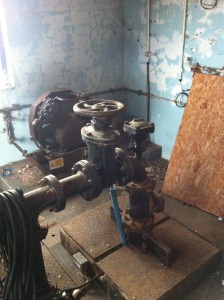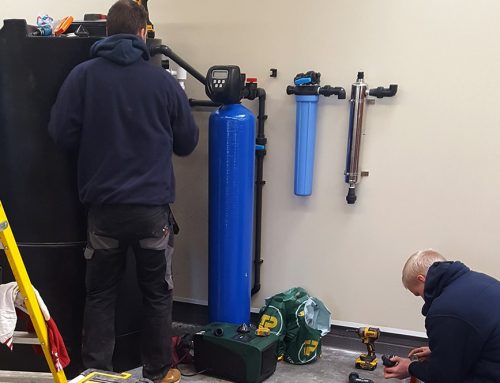Here at Dales Water we recently worked on the decommissioning of a borehole dating back to the 1960’s that had fallen out of use and was no longer required. It’s always nice to see old pieces of infrastructure in place that have stood the test the time and were still capable of bearing water right up until it was no longer required.
In most cases we much prefer to bring boreholes back into commission but we thought we’d talk today about decommissioning a borehole and the processes involved. Ensuring it’s done correctly and in compliance with the Environmental regulations is highly important and isn’t a job that should be undertaken by just anyone.

A Borehole Head Dating Back to the 1960’s
Why Must Boreholes be Decommissioned Properly?
Redundant boreholes that have fallen out of use have to be dealt with properly to make sure they’re both safe to be around physically and to prevent them causing groundwater pollution or wastage. This is because redundant boreholes form a direct pathway to groundwater.
No water well lasts forever; well heads get damaged, steel degrades and in some cases even brand new boreholes pose an immediate risk due to poor construction techniques used by rogue firms who don’t take into the consideration the complexities of fitting a long lasting and efficient borehole. Any well owner who’s had the misfortune of having a borehole drilled that results in the interconnection of water-bearing zones of varying quality knows exactly what we are talking about.
It’s in everyone’s interest to protect water as it’s such an important resource and that’s recognised none more so by the Environment Agency who state the following about abandoned boreholes:
“The Environment Agency (EA) has a duty to promote the sustainable use of water and to ensure it is protected from pollution. The Environmental Permitting (England and Wales) Regulations 2010 require the EA to take all necessary measures to prevent input of so called hazardous substances (for example pesticides) and limit the input of other non-hazardous pollutants (such as nitrate) into groundwater*, including for example contaminated run-off directly entering groundwater via an uncapped borehole.” Source: The Environment Agency
The Dangers of Abandoned Boreholes:
- An unsealed borehole that’s no longer in use leaves groundwater open to contaminants such as farm chemicals, fuels and septic tanks. This often can have knock on effects it opens up pathways / conduits for contaminant water movement across to different aquifers.
- Abandoned boreholes can also contribute to the loss and wastage of water. This negatively impacts aquifer yield and water pressure, effecting water usage for other users in the area.
- Large diameter bore holes or wells can also be potential risk to small children and livestock.
In short, anyone who owns land that has a redundant borehole needs to make sure it is decommissioned properly, ensuring it’s made both safe structurally and backfilled or sealed to prevent groundwater pollution.
Water is a very precious resource so in our opinion the correct decommissioning of a borehole is just as important as the correct installation of one. As is recommend by the Environment Agency and The British Drilling Association we would always suggest that anyone requiring the decommissioning of a redundant borehole seeks the services of an experienced well drilling contractor like ourselves who have good knowledge of the local geology and know the ins and outs of the Environment Agency borehole abandonment procedures.
What’s Involved in the Borehole Decommissioning Process?
No one borehole is ever the same and that often means the decommissioning process is unique at each site.
Location, geology, the original construction, dimensions, other potential risks / hazards are all factors that affect the process and techniques involved. It’s also very important to take into consideration the intended after use of the site in question.
Generally the decommissioning process involves:
- Define the objectives: This objectives of decommissioning a borehole usually take into account removing trip/fall hazards, preventing the borehole acting as a conduit, stopping the mixing of water from different aquifers and to stop the wastage of borehole water from the overflow from artesian boreholes.
- Remove the headworks and casing: This process ensures the well is free from an obstructions that could interfere with the sealing of the borehole itself.
- Backfilling: This is where the borehole is filled to restore to its pre drilled condition. This requires a wide range of materials and must be carried out by a well drilling contractor who knows the area. Certain materials may change under the environmental / pH conditions they are subject to specific to the area. Artesian boreholes must also be treated differently
- Sealing of the borehole: The backfilled borehole should then be capped and sealed (with an impermeable plug) to prevent entry of any foreign objects or contaminated water.
- Recording of details: Any firm carrying out the decommissioning of a borehole should keep accurate records of the job in question. This is both for their own internal record keeping and to inform others that there is a decommissioned borehole within a specific area. The Environment Agency should always be notified of the abandoned well location.
For further advice and guidance on the correct decommissioning of a borehole please contact us and speak to one of our team.



